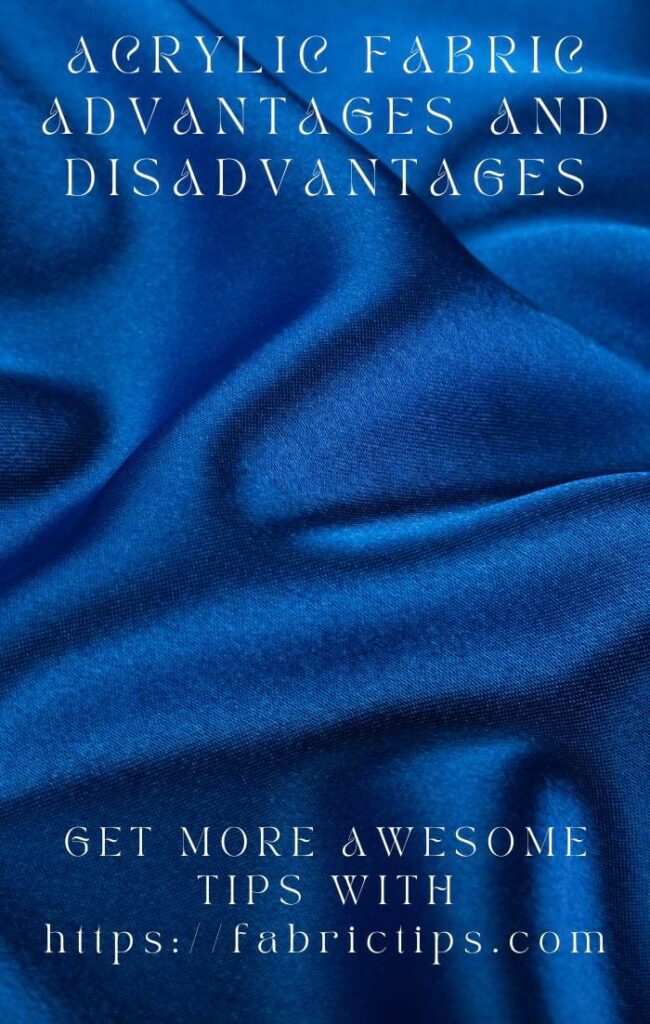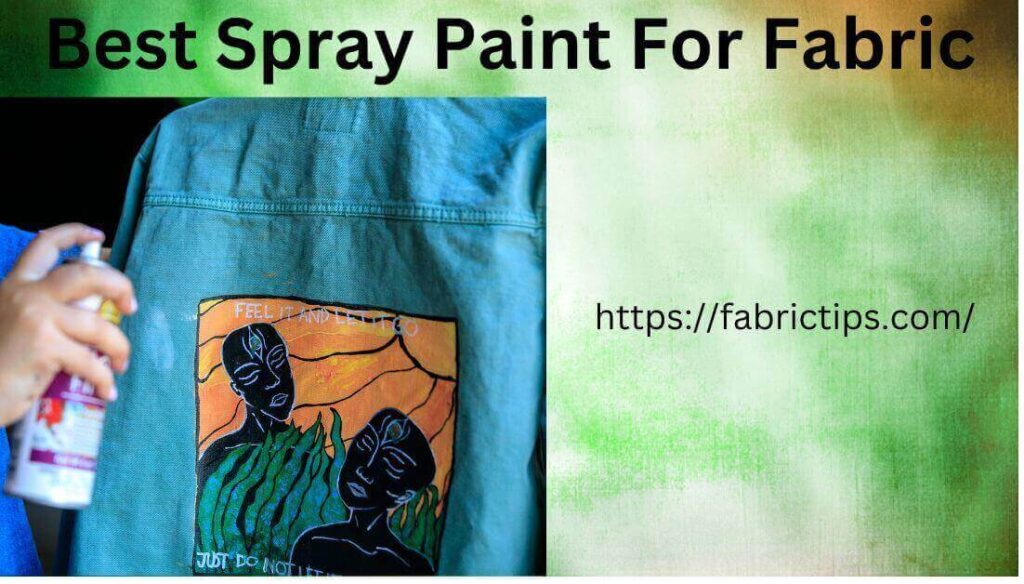Last Updated on May 24, 2025 by Wahid
Some people love acrylic for its bright colors and weather resistance. Others avoid it because it can pill easily, trap static, and feel less breathable than natural fibers. There’s also growing concern about its impact on the environment.
Acrylic fabric is known for being soft like wool but lighter, cheaper, and easier to maintain. It’s widely used in everything from winter wear and blankets to upholstery and outdoor furniture. But while it’s praised for being warm and affordable, it’s not without flaws.
If you’re curious about acrylic fabric, this guide will explain its pros, cons, and best uses. Let’s look at it below.
What Is Acrylic Fabric and How Is It Made?

Acrylic fabric is a synthetic material made from polyacrylonitrile, a polymer derived from petroleum or natural gas. To create the fabric, manufacturers first turn acrylonitrile into long chains through a process called polymerization. These chains are then spun into fibers.
The spinning is done using either a wet or dry method. Once the fibers are formed, they are stretched, washed, and crimped. This helps them look and feel more like natural wool. The finished fibers are then ready to be woven or knitted into fabric.
Acrylic is popular because it’s soft, warm, and lightweight. It’s used in many everyday products, such as sweaters, socks, and gloves. You’ll also find it in home items such as blankets, curtains, and rugs. Thanks to its durability, it’s even used in outdoor gear, like patio furniture covers and awnings.
What Are the Main Advantages of Acrylic Fabric?
Acrylic fabric is a practical, affordable alternative to wool and other natural fibers. It combines softness, durability, and vivid color retention, making it a versatile option for everything from fashion to home goods.
Why Is Acrylic Fabric Considered Lightweight and Soft?
Acrylic is designed to imitate wool’s cozy texture but without its heaviness. It’s light and smooth, making it comfortable to wear even in layered outfits. This softness makes it a favorite for winter essentials like sweaters and scarves.
How Does Acrylic Fabric Perform in Terms of Color Retention?
One of the acrylic’s standout features is its ability to hold color well. It absorbs dyes evenly and resists fading over time, even with sun exposure. This makes it a top choice for bright outdoor fabrics and bold fashion pieces that need to stay vibrant.
Is Acrylic Fabric Suitable for Wet or Humid Environments?
Yes, acrylic does well in damp conditions. It doesn’t soak up water like cotton or wool and dries out much faster. That quick-drying nature means less chance of mildew or musty smells, making it ideal for bathroom rugs or outdoor cushions.
How Cost-Effective Is Acrylic Compared to Other Materials?
Acrylic is much more budget-friendly than natural fabrics like wool or silk. It gives you a similar look and feel without the higher price tag. This affordability makes it a popular option for shoppers who want quality without overspending.
Does Acrylic Fabric Breathe and Dry Quickly?
While acrylic isn’t as breathable as cotton, it still allows for decent airflow. More importantly, it dries quickly when it gets damp. That combination makes it a good fit for casual wear or activewear where comfort and moisture control matter.
What Are the Disadvantages of Acrylic Fabric?
Acrylic may feel soft and offer excellent color, but it doesn’t come without trade-offs. Here’s what you need to know before making your decision.
Why Doesn’t It Breathe Well?
This fabric doesn’t allow air to circulate as freely as cotton or linen. Wearing in warm or humid conditions tends to trap heat close to the body. That can leave you feeling overheated and sticky, especially during summer or active use.
What Makes It Prone to Pilling?
Clothes and textiles from this material often develop fuzzy little balls after some wear. These show up most where there’s regular friction, like under the arms or along seat cushions. Pilling makes items look older and faster, even if they’re still structurally fine.
Is It Bad for the Environment?
Made from synthetic polymers, this fabric isn’t biodegradable. It lingers in landfills and sheds microplastics during washing, ending in waterways. Production also involves strong chemicals that can be hazardous if not properly managed.
Could It Be a Fire Risk?
When exposed to high heat or open flame, it doesn’t just burn, it melts. That melted material can stick to the skin and cause serious burns. This is something to keep in mind when using it in kitchens, around campfires, or anywhere near heat sources.
Why Does It Cling and Hold Odors?
Static buildup is a common issue, leading to uncomfortable clinginess or little shocks throughout the day. On top of that, it tends to hang on to sweat and smells longer than natural fibers. You may need to wash it more often just to keep things fresh.
See Other Post: What Is Acrylic Fabric: In-Depth Analogy
See Other Post: How To Soften Acrylic Paint On Fabric – Tutorials, Tips & Tricks
How Does Acrylic Fabric Compare to Other Common Fabrics?
Each fabric has strengths and weaknesses, depending on the use case. Here’s a side-by-side comparison to help you choose what works best.
| Feature | Acrylic vs Wool | Acrylic vs Polyester | Acrylic vs Cotton |
| Cost | Acrylic is significantly more affordable | Both are cost-effective synthetic options | Acrylic is usually cheaper than cotton |
| Comfort | Warm like wool, but less breathable | Softer and more wool-like than polyester | Warmer and fluffier, but cotton is cooler |
| Durability | Less durable than wool over time | Polyester wins in toughness and wear | Both hold up well, but cotton wears naturally |
| Maintenance | Machine-washable and easy to care for | Both are low-maintenance synthetics | Cotton may shrink and wrinkle more easily |
| Breathability | Retains heat more than wool | Polyester and acrylic are similar—limited | Cotton is far more breathable |
| Environmental Impact | Synthetic and not biodegradable | Both have environmental concerns | Cotton is natural but resource-heavy |
| Use Case | Best for warm knitwear and winter items | Ideal for sportswear and active clothing | Suited for everyday wear and warm climates |
How Can You Care for and Maintain Acrylic Fabric?
Acrylic fabric is durable but still needs proper care to maintain its softness, shape, and color. Here’s how to keep your acrylic garments and textiles looking their best.
Washing
- Use cold or warm water with a gentle cycle.
- Always avoid hot water to prevent shrinking or warping.
- Mild detergent is best to protect fibers.
Drying
- Lay flat to air dry and preserve the garment’s shape.
- If you must use a dryer, set it to low heat.
- Avoid over-drying, which can damage fibers.
Ironing
- Set your iron to a low-temperature or synthetic setting.
- Place a pressing cloth between the fabric and the iron.
- Steam lightly if necessary, but avoid direct heat.
Reducing Pilling
- Turn items inside out before washing to reduce friction.
- Use fabric softener to smooth fibers.
- Choose gentle wash cycles to prevent excess agitation.
Storage Tips
- Store in a cool, dry area away from sunlight.
- Fold garments instead of hanging them to avoid stretching.
- Keep away from sharp items that could snag the fabric.
Who Should Use Acrylic Fabric, and When Is It a Good Choice?
Acrylic fabric is a smart option for people looking for warmth, style, and durability without spending a lot. But it isn’t for everyone, and knowing when it works best can help you make the right choice.
| Best For | Why It Works Well |
| Budget Shoppers | Offers an affordable alternative to wool and other natural fibers for clothing and decor. |
| Outdoor Enthusiasts | Resistant to moisture, fading, and mildew—ideal for patio furniture and awnings. |
| Cold-weather wearers | Lightweight yet warm, making it suitable for sweaters, scarves, and winter accessories. |
| Not Recommended For | Reason for Caution |
| Sensitive skin | May cause irritation or itching for those with allergies or skin sensitivities. |
| Hot Climate Residents | Poor breathability can trap heat and moisture, leading to discomfort in warm conditions. |
| Eco-Conscious Consumers | Petroleum-based and non-biodegradable, with a higher environmental footprint. |
See Other Post: How To Make Fabric Look Like Leather: Quick, Easy & Effective
See Other Post: Can You Use Acrylic Paint On Fabric: Yes or No?
Is Acrylic Fabric Sustainable and Eco-Friendly?

At present, acrylic fabric is not considered a sustainable or eco-friendly material. It is made from petroleum-based chemicals and does not biodegrade, contributing to long-term environmental impact.
That said, the industry is exploring more responsible alternatives:
- Recycled Acrylic: Some manufacturers are exploring ways to reclaim and reuse old acrylic fabrics. This reduces textile waste and reduces the need for new raw materials. While still limited, these efforts mark a step toward circular production.
- Low-Impact Dyes: Eco-friendly dyes use less water and avoid harsh chemicals. They also reduce runoff and pollution during manufacturing, making acrylic slightly less harmful to the environment.
Despite these efforts, acrylic still lags behind more sustainable options like organic cotton, bamboo, or Tencel regarding overall environmental friendliness. Choosing acrylic means weighing affordability and function against its ecological cost.
List Of A Variety Of Acrylic Fabrics
1. Pure Acrylic Fabric:
Made from 100% acrylic fiber. It has a loose and supple structure, a bright color, and an elastic feel and does not feel loose or rotten. The fabric can be used to make women’s clothing of medium and low grades.
2. Acrylic Bulked Yarn:
By using 100% pure acrylic bulked yarn for the plain raw material, a twill woven coat can be made with acrylic bulked yarn. These fabrics have the quality of being warm, relaxing, and full of feeling. This makes them ideal for spring coats, autumn coats, and winter coats. They are also suitable for casual wear.
3. Acrylic Blended Fabric:
The term acrylic blended materials refer to the blend of wool, viscose, medium-length acrylic fibers, and polyester. Including Viscose/Nitrile Gabardine, Viscose/Nitrile Ladies, Polyester/Nitrile Tweed, etc. Polyester/Nitrile Tweed combines 40% to 60% nitrile & polyester, resulting in a flat appearance, a firm feel, and no need for ironing. Unfortunately, it is not as comfortable, so it’s used mostly for mid range suits, outerwear, etc.
Finally, Should You Choose Acrylic Fabric for Your Needs?
Acrylic fabric is a practical, budget-friendly alternative to natural fibers like wool and cotton. Its softness, durability, and weather resistance make it appealing for various uses. However, it falls short in breathability, environmental sustainability, and long-term wear resistance due to pilling.
In summary, choose acrylic fabric if you’re looking for an affordable, warm, and low-maintenance option, especially for cold-weather or outdoor applications. Consider alternatives if eco-friendliness and breathability are top priorities.
With a clear understanding of the advantages and disadvantages of acrylic fabric, you’re now equipped to decide if acrylic fabric fits your style, budget, and purpose
Frequently Asked Questions
Can acrylic fabric shrink?
Acrylic doesn’t typically shrink like natural fibers. However, exposure to high dryer heat can cause it to lose shape or even melt.
Is acrylic good for summer or winter wear?
This fabric is better suited for winter because it retains heat well. In hot weather, it may feel too warm and trap moisture.
Does acrylic feel itchy like wool?
Lower-quality acrylic can feel scratchy against the skin, similar to rough wool. That said, many blends are soft and more comfortable for most people.
Is acrylic fabric waterproof?
While not fully waterproof, acrylic resists moisture and dries quickly. It works well in light rain or humid environments.
Can you dye acrylic fabric?
Yes, acrylic can be dyed, but it needs dispersed dyes and high heat to absorb color properly. Regular fabric dyes won’t work effectively on it.






